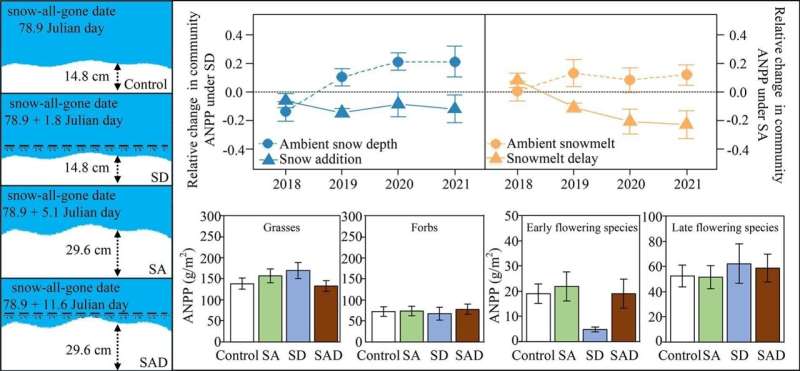This article has been reviewed according to Science X's editorial process and policies. Editors have highlighted the following attributes while ensuring the content's credibility:
fact-checked
peer-reviewed publication
trusted source
proofread
Snowmelt timing impacts grassland plant communities, new study finds

Researchers at the Institute of Applied Ecology (IAE) of the Chinese Academy of Sciences have shed light on how the timing of snowmelt affects the plant communities in grasslands, which are vital ecosystems around the world.
In arid and semi-arid regions, winter snowfall serves as a critical water source during the vegetation greening period, and snowmelt drives the start of the growing season. However, with global changes in temperature and precipitation, winter snowfall amounts, snow depth, and snowmelt timing are shifting, potentially altering early spring soil temperatures and moisture conditions.
Surprisingly, snow changes have received less attention compared to other global change factors such as nitrogen deposition, precipitation variability, and warming.
Led by Dr. Wang Zhengwen, the Ecological Stoichiometry team of IAE set up an experiment to mimic the effects of changing snow patterns at the Erguna Forest-Steppe Ecotone Research Station. Over four years, the researchers simulated increased snow depth, delayed snowmelt, and combinations of these treatments to assess their effect on aboveground net primary productivity (ANPP) and plant species composition.
Interestingly, simply adding more snow didn't affect the plant communities. However, delaying the snowmelt produced some surprising results. Plants started growing later (delayed phenology), but overall growth (measured by aboveground net primary productivity or ANPP) increased. This upside came with a downside: the diversity of plant species decreased, and the overall plant community composition shifted.
The researchers attributed the changes in plant communities largely to the greater sensitivity of graminoids (grasses) to delayed snowmelt compared to forbs (broad-leaved flowering plants that are not grasses).
The study also reveals an interesting interaction: under snowmelt delay treatments, adding more snow excessively prolonged snow persistence, counteracting the effects of snowmelt delay on plant communities.
This work, published in the journal Science of the Total Environment, underscores the importance of snowmelt timing for grassland ecosystem structure and function.
More information: Wang Ma et al, Later-melting rather than thickening of snowpack enhance the productivity and alter the community composition of temperate grassland, Science of The Total Environment (2024). DOI: 10.1016/j.scitotenv.2024.171440
Journal information: Science of the Total Environment
Provided by Chinese Academy of Sciences



















